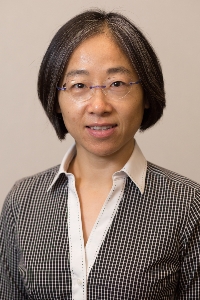Biomaterials for Engineering Muscle Cells, Tissue, and Disease Models

Wei Shen, PhD
Department of Biomedical Engineering
University of Minnesota
Abstract: Biomaterials play important roles in both fundamental biomedical studies and translational medical applications, ranging from engineering cells, tissues, and disease models to delivering drugs and developing medical devices. In this talk, I will discuss using biomaterials to engineer muscle cells, tissue, and disease models in two-dimensional (2D) and three-dimensional (3D) systems. We have discovered that substrates patterned with nanoridges/nanogrooves and functionalized with Matrigel or laminin present an engineered cell microenvironment to allow myotubes derived from non-diseased human induced pluripotent stem cells (hiPSCs) to align nearly perpendicular to nanoridges, while myotubes derived from less-affected and severely-affected Duchenne Muscular Dystrophy (DMD) cells exhibit prominent differences in alignment and orientation, providing a sensitive and highly reproducible phenotypic biomarker to distinguish these cells, which may facilitate early DMD diagnosis and serve as a phenotypic readout for high throughput drug development. We have evidence suggesting that the DystrophinAssociated-Protein-Complex (DAPC), an important transmembrane protein complex that structurally, mechanically, and functionally links the muscle cytoskeleton and the extracellular matrix, mediates this nanotopography-responsive phenotype. In addition, we have established a method to culture hPSCderived 3D muscle constructs, which exhibit significantly greater contractile forces than previously reported, and these tissue models have been used to identify molecules to enhance maturation of hPSCderived myotubes. We have also used these engineering approaches to study myogenic cells directly reprogrammed from fibroblasts.
Biography: Dr. Wei Shen is an Associate Professor in the Biomedical Engineering Department at the University of Minnesota, Twin Cities. Dr. Shen received her Bachelor’s Degree in Chemical Engineering from East China University of Science & Technology in 1992. She received her PhD degree in Chemical Engineering from the California Institute of Technology in 2005, and received her postdoctoral training in the division of biology at Caltech between 2005 and 2006. She started as an assistant professor in the Biomedical Engineering Department at the University of Minnesota in 2006 and was promoted to Associate Professor with tenure in 2012. Dr. Shen is a recipient of the prestigious NSF CAREER award and the Coulter Foundation Early Career Award. Her research interests include biomaterials engineering, tissue engineering, disease modeling, cell-material interactions, and medical devices.